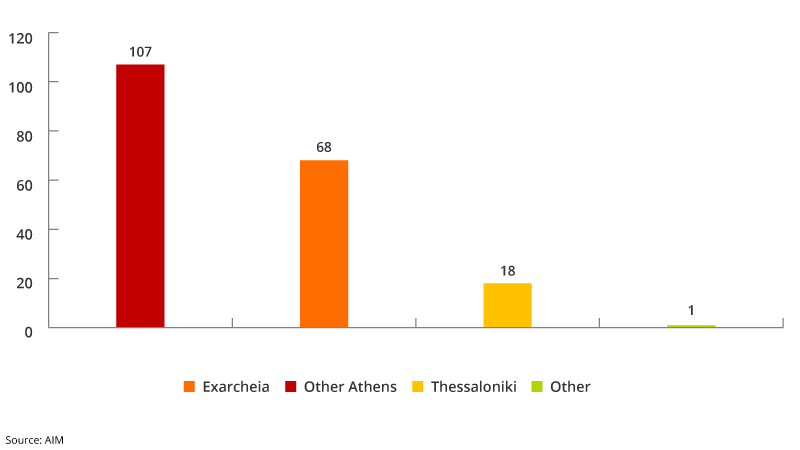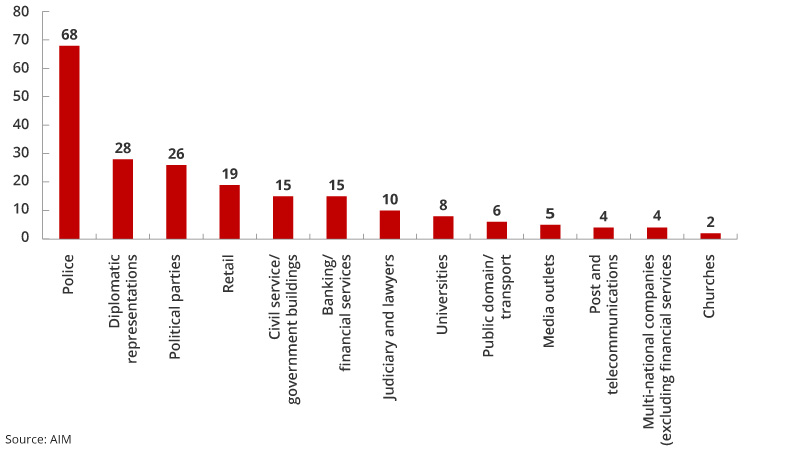The centre-right New Democracy (ND) party came to power in July with a promise to tackle the anarchist groups that have emerged in Greece in recent years.
Four key risk points:
1.Anarchist groups are likely to respond to the government’s efforts to disband them by stepping up their activities in the coming months.2. Government and diplomatic buildings are likely to remain the main targets for attacks, but anarchists are occasionally likely to single out multinational companies in relation to specific controversies.
3. Anarchist methods are likely to continue to be dominated by arson and fire bombings, with occasional use of explosive devices. Anarchists will prioritise material damage rather than casualties.
4. While police actions to disrupt anarchist activities are likely to see some success, a full eradication of all groups is unlikely in the coming years.
Clampdown
Prime Minister Kyriakos Mitsotakis ran on a platform of restoring law and order and singled out anarchist groups as a key target. Mitsotakis argues that the previous, left-wing government under the Coalition of the Radical Left (SYRIZA) was reluctant to crack down on the groups and allowed them to operate largely unhindered. The ND government has indicated that it will increase police funding to respond to anarchist activities and impose longer prison sentences on convicted militants. Mitsotakis has appointed Michalis Chrisochoidis as minister for citizen protection and tasked him with disbanding the groups. Chrisochoidis has form in tackling anarchist groups, having been minister for public order in the early 2000s and part of the team that dismantled the November 17 (17N) anarchist group. 17N carried out a campaign of guerrilla violence targeting Greek and foreign interests in the country from 1975 until 2002, when 19 key members of the group were apprehended. The years following the group’s 2002 disruption saw a reduction in anarchist activity, but the financial crisis that began in 2008 sparked the formation of new groups with new targets.
Fragmented groups
The anarchist threat has changed significantly since the days of 17N. Instead of one major terrorist actor, hundreds of small groups operate, albeit less violent than their predecessor. The authorities estimate that around 450 anarchist cells have emerged over the past decade, of which a handful of higher-profile groups have gained media attention by carrying out multiple attacks.
Among these, the Conspiracy of Fire Nuclei (SPF) in October 2016 launched “Project Nemesis”, which gained support from international anarchist groups, and the SPF carried out a series of attacks starting in late 2016 targeting those institutions perceived to be responsible for the severity of Greece’s economic crisis. Perhaps most notably, police in March 2017 discovered eight parcel bombs at a postal sorting office near the capital Athens, which were addressed to banks and organisations associated with the country’s debt crisis. A small explosive device in April 2017 detonated outside the offices of Greece’s third largest lender Eurobank in the centre of Athens. The group also targeted luxury goods brands.
Since 2018, another anarchist group, Rouvikonas (Rubicon), has been active in carrying out attacks. It has targeted lawyers and judges involved in the sale of foreclosed properties, as well as diplomatic buildings, charities implicated in scandals, and banks – occasionally blowing up automated teller machines (ATMs). The group has also turned its attention to the activities of multinational companies operating in Greece.
As the authorities attempt to break up these groups, new, smaller cells of activists emerge, claiming responsibility for attacks. This fragmentation means that dismantling anarchist networks effectively is a lot more difficult than in the early 2000s and will pose a significant challenge, even if the government is able to restore police funding to pre-crisis levels.
Tactics
Unlike N17, contemporary anarchist groups in Greece generally aim to avoid casualties but use a range of tactics aimed at causing material damage, from vandalising cash machines to firebombing diplomatic missions. Their campaigns tend to proceed in phases during which one or two sectors are targeted, using one or two methods, before new opportunities are identified.
Methods used by anarchists, September 2014-August 2019

The arson or firebomb category in the above graphic is dominated by incidents where Molotov cocktails (homemade firebombs) were used against police during riots. However, it also includes pre-planned acts of arson against specific targets. While recent years have seen the occasional use of improvised explosive devices (IEDs), the groups’ limited capabilities in bomb-making have meant that such attacks will remain much less common than those using easily obtainable materials.
Targets
The targets chosen by anarchist groups have evolved over the past decade, but a handful of sectors have remained perennial favourites. The police have overwhelmingly been on the receiving end of more anarchist violence than other targets, usually in the course of street unrest. However, in terms of pre-meditated attacks, diplomatic representations and political party buildings have been the most frequently targeted.
Attacks on political parties tend to increase in frequency during election periods. In the months ahead of the July election, anarchist groups vandalised buildings belonging to the eventual winner ND, as well as offices belonging to far-right and centre-left parties. With ND now in government, the party is likely to represent the main political target for anarchist groups.
In the years after the eurozone crisis, locations linked to the country’s creditors – the IMF, EU and European Central Bank (ECB) – represented key targets for anarchist groups. Diplomatic sites linked to major Western countries became a particularly popular target for attack. More recently though, the banking sector has begun to bear the brunt of continued anger over Greece’s years of economic hardship.
Anarchists’ targets, September 2014-August 2019

There have been few attacks on non-banking multinational companies, but there is evidence that, as distance from the financial crisis grows, anarchist groups are looking for other targets. Thirty members of Rouvikonas in February 2018 stormed the Athens offices of an international pharmaceutical company, claiming that the attack had been staged because of allegations of bribery against the firm. Later that year, the group attacked the Canadian embassy in Athens with paint and sledgehammers in response to mining activities by a Canadian company in northern Greece, underlining a shift towards increased interest in foreign investors.
In recent months, the price of housing has returned to prominence in Athens, where foreign investors are buying properties in large numbers to benefit from “golden passports” that grant EU citizenship, and short-term tourist rentals are driving up rents for locals. The multinational company Airbnb has become the focus of protests and activists have reportedly been gluing shut the locks of properties listed on the site. Anarchist campaigns in the coming years are likely to develop in response to similar scenarios, where businesses are seen as harming Greek citizens’ standard of living or where scandals emerge.
Exarcheia in focus
The focus of the government’s anti-anarchist action is the Exarcheia area of Athens. The area has long been a centre for left-wing intellectuals, and in recent years Exarcheia has become the epicentre of Greek anarchist activity.

As the above graphic shows, more than one-third of all violent anarchist incidents recorded by Control Risks in Greece over the past five years took place in this small area of central Athens. While some of these were targeted attacks on political opponents, the majority consisted of pitched battles with police in the streets. Riot police are a near constant presence on the area’s edges, but the authorities have been unable to maintain control in Exarcheia itself. When the police have attempted to assert themselves in the face of anarchist activities, clashes have been common, usually involving the throwing of petrol bombs by protesters and use of tear gas by police. Businesses in the area have suffered damage during these clashes.
The authorities in recent weeks have carried out clearances of properties in Exarcheia, leading to violence in the area. In doing so, the authorities have conflated anarchists with criminal actors, as well as with migrants who have made their homes in the area. Further clashes between police and anarchists (as well as with migrants and others opposed to evictions) are likely in the coming months, both in Exarcheia and elsewhere in Athens.
Challenges ahead
Beyond the next few months, the authorities’ focus on Exarcheia is likely to lead to a reduction in anarchist groups’ presence in the area. However, this may simply disperse the groups, making it harder for the authorities to monitor their activities. Meanwhile, the ND’s policy priority of making Greece a more attractive destination for foreign direct investment is likely to continue to feed into the narrative that the state is prioritising big business over citizens, potentially leading to an uptick in activities against multinational companies. As the post-crisis resurgence of groups demonstrates, it is likely to take more than arrests to bring about a permanent eradication of anarchists. Anarchist groups are likely to remain a feature of the threat environment in Greece for a good while yet.
Part of the Big Picture Series, taken from Seerist.
